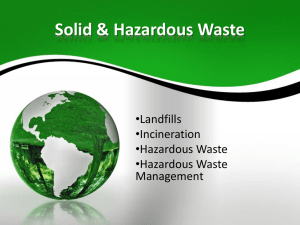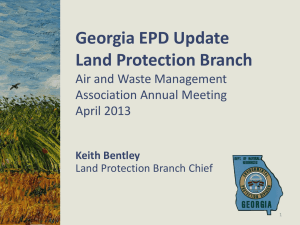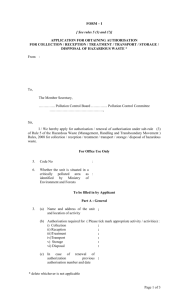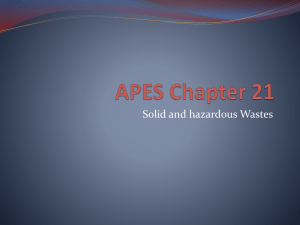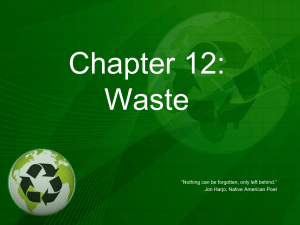Waste
advertisement
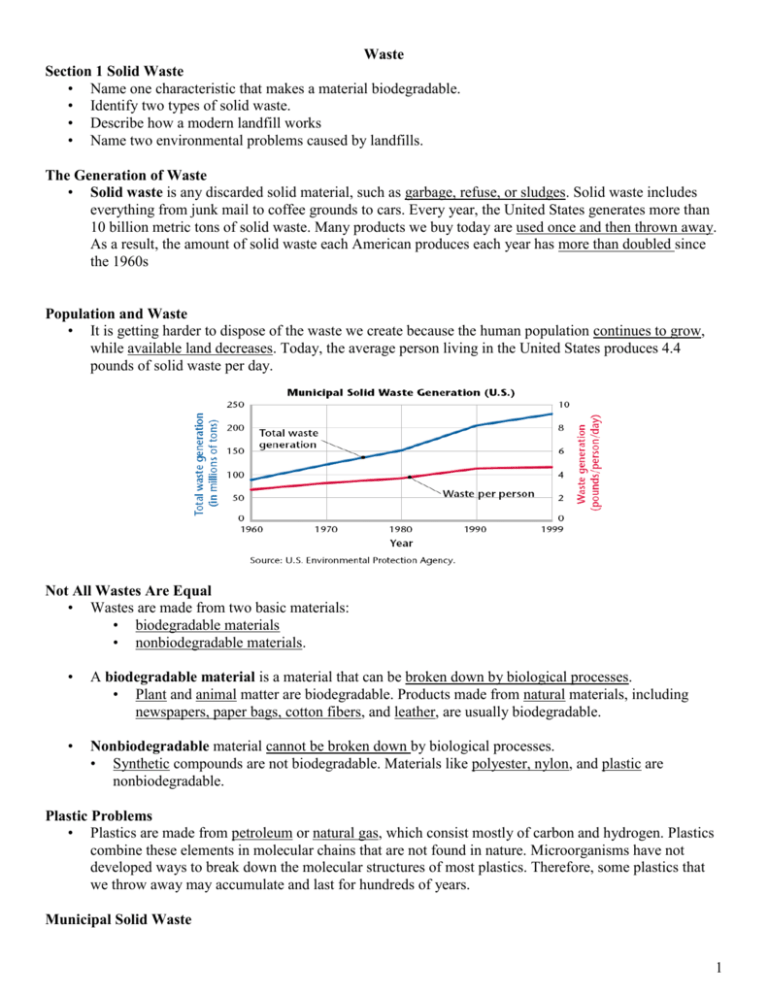
Waste Section 1 Solid Waste • Name one characteristic that makes a material biodegradable. • Identify two types of solid waste. • Describe how a modern landfill works • Name two environmental problems caused by landfills. The Generation of Waste • Solid waste is any discarded solid material, such as garbage, refuse, or sludges. Solid waste includes everything from junk mail to coffee grounds to cars. Every year, the United States generates more than 10 billion metric tons of solid waste. Many products we buy today are used once and then thrown away. As a result, the amount of solid waste each American produces each year has more than doubled since the 1960s Population and Waste • It is getting harder to dispose of the waste we create because the human population continues to grow, while available land decreases. Today, the average person living in the United States produces 4.4 pounds of solid waste per day. Not All Wastes Are Equal • Wastes are made from two basic materials: • biodegradable materials • nonbiodegradable materials. • A biodegradable material is a material that can be broken down by biological processes. • Plant and animal matter are biodegradable. Products made from natural materials, including newspapers, paper bags, cotton fibers, and leather, are usually biodegradable. • Nonbiodegradable material cannot be broken down by biological processes. • Synthetic compounds are not biodegradable. Materials like polyester, nylon, and plastic are nonbiodegradable. Plastic Problems • Plastics are made from petroleum or natural gas, which consist mostly of carbon and hydrogen. Plastics combine these elements in molecular chains that are not found in nature. Microorganisms have not developed ways to break down the molecular structures of most plastics. Therefore, some plastics that we throw away may accumulate and last for hundreds of years. Municipal Solid Waste 1 • Municipal solid waste is the waste produced by households and businesses. Most of what we throw out on a day-to-day basis is called municipal solid waste. The amount of municipal solid waste is growing much faster than the amount of mining or agricultural waste. Municipal solid waste creates more than 210 million metric tons each year of solid waste. And this is only 2 percent of the total solid waste in the United States. Solid Waste from Manufacturing, Mining, and Agriculture • Consumers indirectly create manufacturing waste by purchasing products that have been manufactured. Mining wastes include rock and minerals that are left exposed in large heaps, dumped in oceans and rivers, or disposed by refilling and landscaping abandoned mines. • Agricultural waste makes up 9% of the total solid waste but is biodegradable. The increased use of fertilizers and pesticides may cause agricultural waste to become more difficult to dispose of because the waste may be harmful if returned to the soil. Landfills • A landfill is an area of land or an excavation where wastes are placed for permanent disposal. More than 50% of the municipal and manufacturing solid waste in the United States ends up in landfills. • Landfills must contain the waste that is buried inside and keep it from causing problems with the environment. Waste inside a landfill must not come into contact with the soil and groundwater surrounding the landfill. Landfills are maintained by covering wastes each day with a layer of soil, plastic, or both. Problems with Landfills • Leachate is a liquid that has passed through solid waste and has extracted dissolved or suspended materials from waste, such as pesticides in the soil. Leachate is a problem for landfills because it may contain chemicals from paints, pesticides, cleansers, cans, batteries, and appliances. If landfills are not monitored properly, leachate can flow into groundwater supplies and make nearby wells unsafe to drink. • Methane, a highly flammable gas, presents another problem for landfills. Methane forms as organic wastes decompose deep in the landfill where there is no oxygen. Methane gas can be pumped out of landfills and burned to generate electricity. If methane gas production is not monitored safely, it may seep through the ground and into basements of nearby homes and cause explosions. 2 Safeguarding Landfills • The Resource Conservation and Recovery Act, passed in 1976 and updated in 1984, requires that new landfills be built with safeguards to reduce pollution problems. New landfills must be lined with clay and a plastic liner and must have systems for collecting and treating leachate, as well as vents to carry methane out of the landfill. Adding safeguards to landfills, however, in-creases the cost of building them. Also, finding acceptable places to build landfills is difficult. Building More Landfills • We are currently running out of space that we are willing to develop for new landfills. The materials we bury in landfills are not decomposing as fast as we can fill landfills. Even biodegradable materials, like newspapers, take several years to decompose. There are less active landfills now than in the past few decades because many of the landfills have been filled to capacity. Incinerators • Incinerators are one option for reducing the amount of solid waste in landfills. Incinerated materials do not disappear, but the weight of solid waste is reduced. Incinerated materials can be more toxic than before it was incinerated. Special air pollution control devices help control the amount of toxins released into the air. However, even incinerators with these special air pollution control devices release small amounts of poisonous gases and particles of toxic heavy metals into the air. 3 Section 2 Reducing Solid Waste • Identify three ways you can produce less waste. • Describe how you can use your consumer buying power to reduce solid waste. • List the steps that an item must go through to be recycled. • List two benefits of composting. • Name one advantage and one disadvantage to producing degradable plastic. Reducing Solid Waste • Source reduction is any change in the design, manufacture, purchase, or use of materials or products to reduce their amount of toxicity before they become municipal solid waste. Source reduction also includes the reuse of products or materials. If we produce less waste, we will reduce the expense and difficulty of collecting and disposing of it. Buying Less and Lasting Longer • Consumers can influence manufacturers to reduce solid waste by buying products that have less packaging or that can be used more than once. For example, you could purchase dish towels instead of paper towels. Manufacturers could also reduce waste and conserve resources by redesigning products to use less material and to last longer. Recycling • Recycling is the process of recovering valuable or useful materials from waste or scrap. Recycling also refers to the process of reusing some items. Making products from recycled materials usually saves energy, water, and other resources. For example, 95% less energy is needed to produce aluminum from recycled aluminum than from ore. About 70% less energy is needed to make paper from recycled paper than from trees. Recycling: A Series of Steps • The steps of recycling include: • collecting and sorting discarded materials by type • taking the materials to a recycling facility • cleaning the discarded materials so that they can be shredded or crushed • reusing the shredded or crushed material to manufacture new products • selling the new products to consumers Composting Compost is a mixture of decomposing organic matter, such as manure and rotting plants, that is used as fertilizer and soil conditioner. Degradable Plastics • Photodegradable plastic, unlike nonbiodegradable plastics, is made to become weak and brittle when left in the sun for many weeks. Eventually, it breaks into pieces. Green plastic, is made by blending the sugars in plants with a special chemical agent to make plastics. The production of green plastics requires 20 to 50% less fossil fuel. 4 • This plastic has also been engineered to degrade within 45 days of being thrown away. When green plastic is buried, the bacteria in the soil eat the sugars and leave the plastic weakened and full of microscopic holes. The chemical agent then gradually causes the long plastic molecules to break into shorter molecules. Problems with Degradable Plastics • The main problem with degradable plastics is that the plastic parts are only reduced to smaller pieces, not eliminated. Although this type of plastic can help reduce the harmful effects of plastic litter, the plastic itself will remain just as long as regular plastics. Section 3 Hazardous Waste Objectives • Name two characteristics of hazardous waste. • Describe how one law that governs hazardous waste. • Describe two ways in which hazardous waste is disposed. Types of Hazardous Waste • Hazardous wastes are wastes that are a risk to the health of humans or other living organisms. • They may be solids, liquids, or gases. They often contain toxic, corrosive, or explosive materials. • Some examples are • dyes, cleansers, solvents, plastics, and pesticides. • An improperly maintained hazardous waste disposal site can leak toxic waste into the air, soil, and ground water. Federal laws were passed to clean up old waste sites and regulate future waste disposal. Resource Conservation and Recovery Act • The Resource Conservation and Recovery Act (RCRA) requires producers of hazardous waste to keep records of how their wastes are handled. • The RCRA also requires all hazardous waste treatment and disposal facilities to be built and operated according to standards that are designed to prevent the facilities from polluting the environment. The Superfund Act • In 1980, Congress passed the Comprehensive Environmental Response, Compensation, and Liability Act, more commonly known as the Superfund Act. This act gives the EPA the right to sue the owners of hazardous waste sites who had illegally dumped waste. It also allows the EPA to force the owners to pay for the cleanup. 5 • Cleaning up improperly discarded waste is difficult and extremely expensive. The act also created a fund of money to pay for cleaning up abandoned hazardous waste sites. Cleanup has been completed at only a fraction of the roughly 1,200 approved or proposed Superfund sites. Preventing Hazardous Waste • One way to prevent hazardous waste is to produce less of it. For example, manufacturers discovered they can redesign manufacturing methods to produce less or no hazardous waste. • Another way to prevent hazardous waste is to find a way to reuse it. For example, a company that would usually throw away a cleaning solvent after one use can instead sell it to another company that produces a product that is not harmed by small amounts of contamination in the solvent. Conversion into Nonhazardous Substances • Ex) cyanides, which are extremely poisonous compounds, can be combined with oxygen to form carbon dioxide and nitrogen. • Ex) Sludge from petroleum refineries may be converted by soil bacteria into less harmful substances. Land Disposal • Most of the hazardous waste produced in the United States is disposed of on land. Hazardous wastes in concentrated or solid forms are often put in barrels and buried in special landfills. These landfills have extra safety precautions to prevent leakage. • Deep-well injection involves deep-well disposal of hazardous waste. Deep-well injections pump hazardous wastes deep into the ground, where they are absorbed into a dry layer of rock below the level of groundwater. The wastes are then covered with cement to prevent contamination of the groundwater. 6 • A surface impoundment is a natural depression or a human-made excavation that serves as a disposal facility that holds an accumulation of wastes. Surface impoundments are basically ponds with sealed bottoms. Wastes accumulate and settle to the bottom of the pond, while water evaporates from the pond and leaves room to add more wastes. Biologically Treating Hazardous Waste • Some hazardous wastes can be absorbed, broken down, or their toxicity can be reduced when they are treated with biological and chemical agents. Certain bacteria and chemicals can be used to help clean up an area in the environment that has been contaminated with hazardous substances. • Flowering plants and trees that absorb heavy metals can also be planted in contaminated areas. Incinerating Hazardous Waste • Some hazardous wastes are disposed of by burning in specially designed incinerators. Incineration can be a safe way, but it is generally the most expensive form of disposing waste. Incinerators need pollution-control devices and they need to be monitored for hazardous gases and particles. Incinerators produce ash that needs to be buried in a hazardous waste landfill. Hazardous Wastes at Home • Household produces can also create hazardous waste. Some household products should be disposed of in specially designed hazardous waste landfills, and not down the drain or put in the trash for a solid-waste landfill. 7



